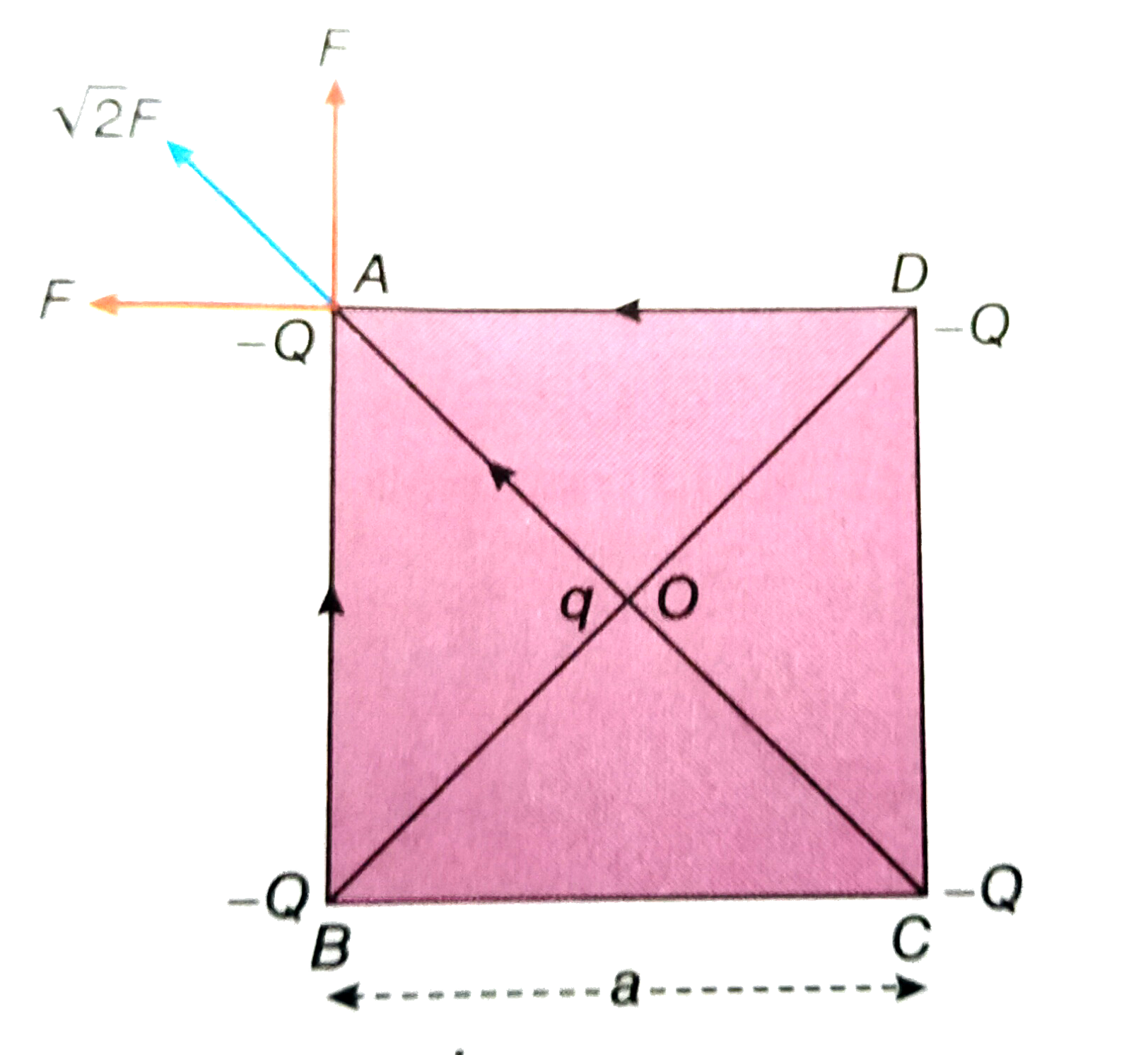Four charges each of −Q, are placed at the four corners of a square. Find out the value of a charge q placed at the centre of the square, such that all the charges would be at equilibrium. Solution in Bengali
Let each side of the square =a [Fig.]

∴AC=√a2+a2=√2a and AO=AC2=√2a2=a√2
Force on the charge −Q at A due to the charge −Q at B.
F=14πε0.Q2a2, along −−→BA
Similarly, the force on −Q at A due to −Q at D will also be F1, but along −−→DA.
The resultant of these two forces will be,
F1=√F2+F2=√2F=14πε0.√2Q2a2, along −−→CA
Again, force on −Q at A due to the charge −Q at C.
F2=14πε0.Q2(√2a)2=14πε0.Q22a2, along −−→CA
Now, force on -Q at A due to the charge q at O.
F3=14πε0.qQ(a√2)2=14πε0.2qQa2, along −−→CA
At equilibrium, the resultant of these three forces along −−→CA must be zero, i.e.,
F1+F2+F3=0 or 14πε0[(√2Q2a2+Q22a2−2qQa2)]=0
or 14πε0.Qa2[Q(√2+12)−2q]=0
or Q(√2+12)−2q=0
or 2q=Q2√2+12 or, q=Q4(2√2+1)
Topper's Solved these Questions
- ELECTRIC FIELDBOOK - CHHAYA PUBLICATIONCHAPTER - ELECTRIC FIELDEXERCISE - SECTION RELATION QUESTIONS
50 Videos
- ELECTRIC FIELDBOOK - CHHAYA PUBLICATIONCHAPTER - ELECTRIC FIELDEXERCISE - HIGHER ORDER THINKING SKILL QUESTIONS
33 Videos
- ELECTRIC ENERGY AND POWERBOOK - CHHAYA PUBLICATIONCHAPTER - ELECTRIC ENERGY AND POWEREXERCISE - CBSE SCANNER
7 Videos
- ELECTRIC POTENTIAL BOOK - CHHAYA PUBLICATIONCHAPTER - ELECTRIC POTENTIAL EXERCISE - CBSE Scanner
13 Videos
Similar Questions
State Coulomb's law regarding the force of interaction between two point charge. Define the unit of charge from this law.
View SolutionTwo charges, +qand−q are separated by a distance d. At which points will the resultant electric field intensity be directed parallel to the line joining the charges ?
View SolutionA light bulb is rated 100 W for 220 V ac supply of 50 Hz. Calculate
the resistance of the bulb ,
View SolutionA test charge q is moved without acceleration along the path from A to B from B to C in electric field E as shown in fig.

(i) Calculate the potential difference between A and C.
View SolutionFour charges equal to -Q are placed at the four corners of a square and a charge q is at its centre. If the system is in equilibrium the value of q is
View SolutionFour charges equal to −Q are placed at the four corners of a square and a charge q is at its centre, If the system is in equilibrium the value of q si
View SolutionFour identical charges i.e. q is placed at the corners of a square of side a . The charge Q that must be placed at the centre of the square such that the whole system of charges in equilibrium is
View SolutionFour charges, each of value q, are placed at the four corners of a square of side a. What is the potential at the centre of the square
View SolutionFour charges equal to Q are placed at the four comers of a square and a charge q is at its centre . If the system is in equilibrium , the value of q is
View Solutionचार आवेशों जिनमे प्रत्येक का आवेश q है a भुजा के वर्ग के कोनों पर रखा गया है| किसी एक शीर्ष पर स्थित आवेश की स्थितिज ऊर्जा क्या होगी ?

View SolutionFour identical charges each .q. are placed at four corners of a square of side .a.. Find the charge to be placed at the centre of the square so that the system of charges is in equilibrium
View SolutionFour charges equal to - Q placed at the four corners of a sqare and a charge q is its centre. If the system is in equilibrium, the value of q is
View SolutionFour charges equal to - Q placed at the four corners of a sqare and a charge q is its centre. If the system is in equilibrium, the value of q is
View SolutionFour charges equal to -Q are placed at the four corners of a square and a charge q is at its centre. If the system is in equilibrium , the value of q is
View SolutionFour identical charges each ‘q’ are placed at four corners of a square of side 'a'. Find the charge to be placed at the centre of the square so than the system of charges is in equilibrium.
View Solution
